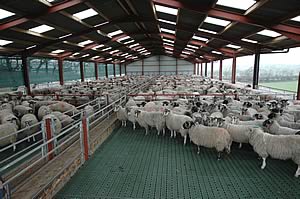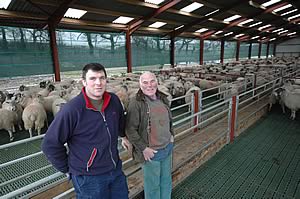26/03/08
New sheep housing has provided all-round benefits in efficiency,
welfare and for the environment on a West Cumbrian upland unit.
The new sheep house with in-lamb ewes
 |
The building at Rigg House Farm, Branthwaite, near Workington,
can house up to 800 ewes for two months pre-lambing, relieving
grazing ground and improving management and feeding efficiency
for father and son John and Adrian Bateson.
Its design was carefully considered by the Batesons and they chose
a single span shed which is open on three sides with a plastic
slatted floor which has enough clearance underneath to allow mucking
out with a small tractor and scraper.
A boost to the project was a grant from the Farming Connect Cumbria
programme draws to a close this year after injecting almost £7.5
million of capital as well as technical advisory work into the
county’s farms since its inception in 2004.
The North West Development Agency scheme has been run under the
umbrella of Cumbria Rural Enterprise Agency, based at Redhills,
near Penrith, working with as many as 1,500 farmers, around half
of whom have been awarded grants.
John Bateson and his son Adrian
 |
The Batesons run 1,200 ewes plus hoggs, principally North of England
Mules and some Swaledales which are crossed with the Texel. The
larger hoggs, around 50 per cent of them, are also lambed.
Half the sheep are wintered at Allonby but they return to Rigg
House by mid-January to lamb in April.
“We wanted the new building to house the ewes throughout
the winter feeding period. This is a heavy farm and the land is
quite wet and it benefits the ground if we can get sheep off the
field,” said Adrian Bateson, who farms in partnership with
his parents John and Sheila and his grandmother Betty.
“It provides an early spring bite for the ewes which get
no concentrate after lambing and helps prevent poaching of the
ground. Numbers of sheep outwintered on the high ground which runs
up to 700ft have been reduced to 450.
“We have gone into the Entry Level Stewardship Scheme and
we have considered the requirements for the Higher Level Scheme
although we are keen to continue farming as we are at the moment.
We are proud of the wildlife on the farm.”
Rigg House runs to 218 hectares, all of which is grassland and
much of it improved by Adrian’s father and grandfather who
bought the former tenanted farm. It also carried a herd of 80 predominantly
Limousin cross sucklers put to the Charolais bull, with progeny
sold finished or store, depending on the market.
Over recent years, with de-coupling cow numbers have been reduced
to concentrate on an increased number of sheep.
The building was
completed in five months just in time for housing the ewes last
year but this spring the Batesons are expecting to see the benefits
to the ewes in better feeding management and from an ideal environment.
Previously, ewes were trough-fed concentrates in the field and
brought inside into the range of other straw-bedded buildings just
before lambing.
 |
The new building roof is 150ft by 62ft, the width including a 5ft
canopy at either side to shelter the feed barrier which has enabled
complete diet feeding. It was built by Klaus Troll engineering
of Corney Fell, Millom and erected by Tony Stamper, of Boonwood,
Gosforth.
It is divided into 10 fixed pens, which are accessed by gates from
a central 4ft passage and the feed barrier which also comprises
gates, allowing sheep to easily be removed from individual pens.
The slatted floor construction which has a 7ft clearance underneath
to allow mucking out by a scraper tractor accounted for a quarter
of the building’s cost
“We decided to opt for a slatted floor as it means that going
on recommended guidelines we can house more sheep in a lesser area.
This has saved on building costs because we would have had to increase
the size of the shed by as much as 50 per cent,” said Adrian.
“The slats will also save on bedding costs and in labour
for bedding which alone we think will pay for itself within 10
years. We are also expecting to have fewer foot problems as there
is no moist, warm straw to encourage the bugs to grow.”
He saw the German-made slats which are made for the pig industry
on a friend’s farm at Kirkby Stephen although he and his
father had looked all types of slats.
The slats have an 8ft span and the bearers are glass fibre to avoid
metalwork corrosion and a minimum life expectancy of 25 years.
They opted for fixed rather than removable slats as they were cheaper
and felt there would be potential problems in having to remove
them to clear out the manure.
A removable wind break has been hung on the storm side of the building
and it can be taken off to allow a freer air flow on still and
muggy days and Adrian says it is proving surprisingly effective.
However, while the building is open on three sides, draft is prevented
from coming up through the slats by sealing off the underground
muck storage area doorway.
“The sheep seem very content in the new building and first
thing in the morning they are all lying down,” said Adrian.
All the ewes are scanned soon after housing time which then enables
them to be grouped according to how many lambs they are carrying
as well as when they are due to lamb.
The housed sheep are initially fed ad-lib silage, eating around
3kg a day. The older housed ewes will be the first to receive the
TMR diet based on clamp and round bale silage, crushed barley,
distillers dark grains and molasses on a rising scale of feeding
up to lambing to 1kg a day of concentrate while reducing silage
content of the diet.
The diet is fed once a day in the morning taking about half an
hour and pushed up later to allow it to be cleaned up over night.
“Previously, we had to mix the concentrates and bag it up
before taking it out to the field and running it into troughs,” said
Adrian.
“It saves at least an hour a day and now it’s a one-man
operation where before it took two people.
“Feeding the concentrate in the field created a mad rush
from the sheep to get to the trough and now the feed is in front
of them all day and there is little competition for it.
“It allows us to make our feeding system much more efficient
giving the most feed to the ewes that need it and hopefully saving
on costs. Before building the new shed the smallest batches of
sheep we could have for management purposes were 200.
Immediately at or prior to lambing, the ewes are taken from the
new building and housed in the range of other buildings in individual
lambing pens to prevent mis-mothering. Later lambing ewes can then
be brought into the new building. Geld or ewes carrying single
lambs are not housed.
“Our current lambing percentage is 180 for lambs sold but
we would like to see every ewe leaving the shed with two lambs
and better feed management should help us achieve that. Lambs are
sold from July through to January.”
Another benefit of the underground muck storage is that the manure
can be applied to the land at optimum times. The Batesons also
hope to carry out nutrient planning.
Last year the building was used to contract finish 1,400 bacon
pigs, taking them from 40 to 100kg – creating extra income
towards the cost of the new building.
“The building has been a great success already and the grant
was a huge benefit in a project like this,” said Adrian.
“Without the grant the building probably would not have gone
up so quickly and if it hadn’t been built last winter I doubt
if it ever would have been following last year’s poor prices
for lambs,” he added.
 Bright Future for British Blondes Bright Future for British Blondes
 Growing Maize as a Cost-Effective Fodder Crop Growing Maize as a Cost-Effective Fodder Crop
 Lakeland Brand Helps Beef Up Prices Lakeland Brand Helps Beef Up Prices
|





